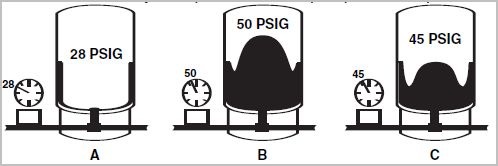What does a pressure tank do? A pressure tank is installed in your home as a means of stabilizing the water pressure and protecting the well pump from short cycling. If your home is supplied by well water, odds are you have a pressure tank close to it. The pressure tank has two chambers inside of it; one for water and the other contains compressed air.
How a water supply pressure tank works
Residential pressure tanks simply use air pressure acting on a rubber diaphragm to force the water out of the tank. When your well pump kicks in, the water acting on the rubber diaphragm compresses the air inside the tank keeping an equal balance of water to air pressure. This process is controlled by the pressure switch and keeps your pump from turning on and off every time there is a demand for water.

The image above shows the air chamber (white) and the water chamber at various stages of use.
- Pressure tank A – shows the tank void of water and the factory precharged air pressure of 28 PSIG (pounds per square inch gauge)
- Pressure tank B – shows the water pressure; pumped up by the well pump, compressing the air chamber.
- pressure tank C – show the air pressure acting on the water chamber as there is a demand for water somewhere in the home. When the pressure in the tank drops below the cut-in of the pressure switch (usually 30 psig) the well pump will again fill the tank and compress the air chamber.
Pressure tanks for residential use usually come precharged (28 PSIG) with air but the air pressure can be adjusted to suit the desired application.
